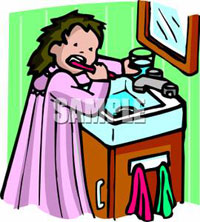LOOKING into your mouth is in some ways like looking under the hood of your car. Both are dark and mysterious places, each having its own particular smell, and you generally have a little idea what you are looking at.
 You would like to know more, and for your car, you would get out the owner’s manual and read it. But what about for your mouth?
You would like to know more, and for your car, you would get out the owner’s manual and read it. But what about for your mouth?
Unfortunately, your mouth did not come with an owner’s manual; you have only the information your mother, your dentist, and some semi-enlightened writers have given you. Both your car and your mouth will run better with a bit of preventive maintenance. Changing the oil in your engine will give you a greater chance of additional years of trouble-free service; so will removing the plaque from your teeth.
The mouth is one of the most important parts of the human body; it serves a survival function as the portal of entry and initial processing point of food. It allows you to speak, which is the primary mode of communication in your daily life. Strong emotions, positive and negative, are transmitted both through spoken words and through the shapes formed by the mouth and lips. In addition, your mouth contributes greatly to your overall appearance and sense of self.
A bright, cherry smile with a display of “white” teeth always gets a positive response. It is one of your most nonverbal cues when you see someone, whether it is for the first or thousandth time. Cosmetic and toothpaste companies spend, and make, fortunes marketing products intended to make a more pleasing smile.
In contrast, people who are self-conscious about their mouths may not smile at all; may smile with their lips pursed tightly over their teeth; or may cover their mouths with their hands. An unsightly smile detracts from an otherwise attractive appearance. Although clothes may “make a person”, a pleasant smile completes the ensemble.
“Don’t take it personally, Doc, but I hate coming to the dentist!” is an all-too-common refrain I hear frequently in my clinic. Sometimes this sentiment is based on previous experience, but, often, it is culturally engendered. Jokes about the agonies of extractions and root canals pervade modern culture. Horror stories about visits to the dentist are traded at beauty salons and over cold beers. But in reality, it is far from the truth.
Well-meaning parents, when taking children to a first dental appointment, tell them it is not going to hurt (thus introducing the possibility that it might). Most dental treatment is almost completely painless, or, at worst, is mildly uncomfortable. The advances in modern pain control, including the use of local anaesthetics administered with narrow, razor-sharp needles, the appropriate use of sedatives, and the pre-and post-treatment use of anti-inflammatory analgesics have taken most of the pain out of dental treatment.
For many people, it is the fear of pain that leads to procrastination in seeking help for dental problems. Sometimes, it is the cost. Remember that dental pain usually has a readily detectable cause. It may be related to decay in a tooth, transient damage to gum tissue, an abscess, or a canker sore or other mouth ulcer.
If related to a decayed tooth or gum abscess, the pain may pass temporarily, but often returns at a higher level. This cycle may continue until the pain is unbearable (usually late on a Saturday night), and damage that is irreversible or that will involve costly treatment has occurred.
The truth is that modern dentistry, especially in the area of prevention, has progressed to the point where, in most cases, tooth decay and gum disease are preventable. You can maintain your teeth and gums in a healthy and comfortably functioning state for your entire life, though it will require a bit of daily attention on your part.
Of course, there is no such thing as a free lunch: You have to have professional dental check-ups. The role you will have to play in maintaining good oral hygiene is hinged mainly on the Rule of Thoroughness. This Rule states that the amount of natural teeth in your mouth used as minutes every 24 hours decides the total time you should spend brushing your teeth, tongue and gums, as well as flossing. In other words, if you have, say 26 teeth in your mouth, you should spend a total of 26 minutes every 24 hours conducting oral hygiene procedures.
This week will mark twenty-two years since this weekly column is being published, and consistent readers should know that my general point is that the effective control of dental plaque is the major key to oral health



.jpg)








